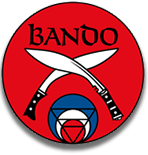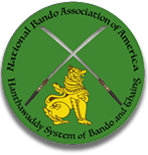The Bull system is not for everyone. There are some subtle prerequisites, such as proper attitude. Like a beast of burden, a Bull practitioner must be willing to both build and abuse his body in a systematic manner. Black is the official color of the Bando system, but the unofficial colors of the bull system are black and blue — for the bruises a student must endure while training. Additionally, the Bull student should not be prone to unnecessary aggression. Like a real Bull, he is not a predator; he should be tolerant of others — up to the point of “trespass”. The practitioner’s body type is also important. “If you want to study the Bull system,” Dr. M. Gyi explains, “you’ve must have a big bone structure and muscles to be able to take the shock of impact”.
Bull training builds hardened weapons that have no specific targets. Through the slow, systematic toughening of the skin, muscle and bone, a student’s fist, forearms and elbows become “horns,” and his shins and feet become “hooves.”
Although a Bull stylist’s fighting techniques are somewhat slower than those of other animal systems, his use of full body power and hardened weapons, plus his willingness to strike his adversary’s bone’s, joints and spine, makes him a significant threat to any attacker.
The Bando Bull stylist also incorporates body-hardening methods into his training. By practicing techniques against the “bull post” and the “bull bag,” students get the abusive impact training necessary to hone their “horns” and “hooves.”
Bull practitioners force themselves to endure pain and use correct techniques in a specific pull / twist / turn motion. They gradually increase the number of repetitions and the power of their blows as their bodies toughen. The training must be maintained on a regular basis otherwise the bodies conditioning will degenerate. In addition to body-toughening drills, Bull stylists must perform strength-building exercises that promote “body lock” — the instantaneous tightening of muscles and joints — which adds support to a powerful technique upon impact with a solid object. In addition to other exercise routines, Bando stylists build strength by lifting logs and scaling ropes.
Proper breathing is extremely important in each of the Bando Animal Systems. By keeping air low in his lungs, the Bull practitioner is able to deliver up to six techniques in one breath. Further distinguishing the Bull system from other Bando animal styles is it lack of specific targets. In the Bull system, everything is a target. A “horn” punch that might be used to break an opponent’s neck could, from a different angle, also be employed to “gore” or scoop up an attacker’s leg.
Because of his use of the body-lock technique and low breathing, a Bull practitioner’s punches can become as powerful as his kicks. His thrusting kicks are generally low stomping maneuvers delivered no higher than the opponent’s abdomen or floating ribs. Provoked into violence, a Bull stylist might just as soon as punch or elbow an opponent’s incoming kick as to hit any other part of his foe’s body. Even the Bull system’s six basic blocks are intended to strike an incoming arm or leg. The Bull system, with its emphasis on middle and short-range techniques, makes full use of the “weapons destruction” principle. The Bando Bull system includes a “tornado” technique, in which the Bull stylist spins toward his opponent and delivers a shin kick/front-hand smash followed by a rear – hand hook punch and/or sweeping kick to the back of the thigh. The Bull practitioner locks his body as he executes a powerful spin of up to 360 degrees. The air around him becomes filled with his flesh and bone “debris” and threatens anybody within his turning radius.
In the lesser-known Burmese art of Bando, there are nine subsystems patterned after animals. The most noteworthy of these is the bull style, which offers the most powerful animal techniques in Bando.


